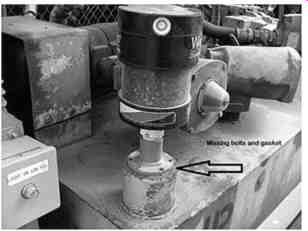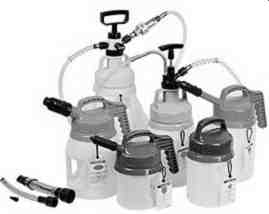AMAZON multi-meters discounts AMAZON oscilloscope discounts
.Eight (8) ways operators can ensure the effectiveness of a lubrication program:
• Check levels in all reservoirs--This is most important for small reservoirs such as overhung pumps and motor bearings that do not have an oil circulation system. Watch for increasing oil levels in equipment. In turbines it can mean steam seals are leaking, allowing the steam to enter the bearing housing and condense. In reciprocating compressors rising levels mean water is entering the crank case and accumulating. Since water is in the bottom of the reservoir and the lubricating pumps suck on the bottom of the reservoir or crank case, water will be circulated like oil and cause shorter machine life.
• Check oil color--If the lubricant is no longer the color it was when first installed the question "why" should be asked. If the answer is not readily available then contact someone with more expertise to solve the problem.
• Paper test--put a drop of oil onto a paper towel or napkin; the oil will be wicked away. If there silver or golden specks are visible, something metallic is coming apart. The presence of metallic particles could be due to a failing bearing or severe rubbing taking place inside the machine. If water droplets are standing on the towel there is water in the reservoir. Look for a change in color from when the oil was new.
• Smell the oil--See explanation below in the section "The nose knows".
• Check seals. Oil reservoirs must be closed to outside elements, preventing dust or contaminants from entering. If there is a cap, make sure it is in place and tight with a gasket. If there is a flanged opening, check that it has a gasket and is sealed tightly

FIG. 1 Desiccant appears to have reached half its useful life. Notice,
the missing attachment bolts and gasket.
• Check desiccant breathers on reservoirs. They must have active material inside so they can continue to remove moisture from the reservoir (see FIG. 1). Most manufacturers have a color code, similar to the yellow, green, black strip seen in FIG. 1, that will determine when the desiccant material needs to be replaced.
• Check containers with lubricant or a barrier fluid reservoir making sure they are well sealed and that automatic closing mechanisms are working properly. This ensures that rain or steam from the area cannot enter the fresh oil (see FIG. 2). If you must keep a container near a piece of equipment to fill the reservoir often, tell someone of the problem so they determine the cause of the excessive oil usage. This can create a housekeeping problem as well.

FIG. 2- Oil containers designed for sealing against the elements and control
led pouring of lubricants.
• Know the correct lubricant to add to a reservoir when it needs to be topped off. Marking the type on the reservoir can prevent adding the wrong kind.
Improving Electric Motor Lubrication Policies
Electric motors-more specifically, grease-lubricated electric motors-are the prime movers for most machines in plants and factories. Motors that are larger than 25 horsepower require occasional regreasing. Doing so properly is essential to maintaining equipment reliability. Upon inspecting poorly lubricated motors, we often see signs of over greasing, under greasing, caked up thickener suggesting dry-out or too long between grease additions, and a "rainbow" of colors, indicating that the motor is being greased with whatever product is handy. All of this indicates a lack of control over the motor lubrication process.
Here are some good reasons to improving your motor lubrication techniques if you are responsible for their lubrication.
Facts and Observations
• Over greasing bearings increases heat and leads to separation of the oil from the thickener, as well as to grease getting into the windings. Overheating and separation compromise bearing reliability. Grease in the windings inhibits heat transfer and increases the rate at which motor insulation material degrades. An increase in temperature of the insulation on a motor reduces the motor life in proportion to the high temperature. The higher the temperature above that recommended on the name plate, the shorter the motor life will be, which is why motors should not be run overloaded or within their stated service factor. (A motor's stated service factor ( SF) is an indication of temporary overload capability that will not result in damage.)
• Under greasing the motor reduces film thickness, which increases frictional heat in the bearing.
This causes the oil to separate from the thickener, which leads to caking. Under greasing can cause the bearing to run in the boundary layer regime and the bearing life will be shortened.
• Mixing greases can lead to a range of problems. First, counter to conventional wisdom, it is not true that "grease is grease." Grease is a complex combination of chemicals-base oil, additives, and thickener. Motor bearings require the right combination of performance characteristics for the application. Failure to deliver these properties compromises motor reliability. Also, grease components don't always play nice with one another. Incompatibility can cause separation of the base oil and thickener, sludge, varnish, and compromised lubrication performance.
• Using the wrong grease is frequently selected. Multipurpose greases can reduce motor life.
First, there is no particular standard for "multi-purpose grease". Its base oil is typically higher than what's required for an electric motor application, which wastes energy and unnecessarily generates heat. It may or may not utilize a thickener that's appropriate for the application, and multi-purpose grease frequently contains an extreme-pressure (EP) additive that can cause corrosion of the bearing cage and on windings in the event of over lubrication.
The Nose Knows--Using Odor as a Test for Your oils
Odor, like color, clarity, presence of foam and other characteristics of the oil that can be evaluated with the human senses, can effectively identify degradation or contamination of lubricating oils. As simple as it seems, smelling oils should be a regular part of routine machine inspection process. A lot of caution should be exercised when smelling oil samples. Do not place the sample directly under your nose-remember that there may be toxic chemicals in the sample from the process. Rather, wave your hand above the opening to waft the scent toward your face. Sometimes it helps to heat the oil, or take a "live" sample as from a dip stick, which increases the likelihood of detecting certain contaminants and degradation by-products.
Odor assessment, when used often, will train the nose to detect many potential problems with oil.
Contaminants such as ammonia, chlorine and other chemicals are easily detected and generally affect the lubricant in a negative way.
Typical odors associated with lubricant problems you can expect to find:
• Oxidation-sour or pungent odor, acrid (rotten egg) smell, or something similar to stale cheese
• Thermal Failure-smell of burnt food or burned oil
• Bacteria-stench, road-kill smell
• Contaminants-solvents, refrigerants, degreasers, hydrogen sulfide, gasoline, diesel, kerosene, and process chemicals will have the lubricant smell of the specific contaminant.
• Amino Acids--fish odor
• Nitro Compounds--almond-like scent
• Esters (Synthetic Lubricants) and Ketones-perfume odor
• Chemicals-odor of the chemical being pumped or compressed
QUIZ
1. List 5 of the 8 ways operators can ensure the effectiveness of a lubrication program.
2. electric motor bearings increases heat and leads to separation of the oil from the thickener, as well as to grease passing the labyrinth and getting into the windings.
3. How can you tell when the desiccant on the reservoir breather needs to be changed?
4. List three smells of lubricant that can tell something about its condition.
5. List two ways to know what the correct oil to add to a reservoir is.
6. Describe what a good container for oil should have.
Answers
1. List 5 of the 8 ways operators can ensure the effectiveness of a lubrication program:
• Check levels in all reservoirs
• Check oil color
• Use the paper towel test
• Smell the oil
• Always insure oil reservoirs are closed to the outside elements preventing dust or contaminants entering.
• If there are desiccant breathers on your reservoirs, ensure they still have active material inside, so they can continue to remove moisture from the reservoir.
• If there are containers with lubricant to add to a piece of equipment or barrier fluid reservoir ensure the container is well sealed or of the automatic closing type to prevent rain or steam from entering fresh oil.
• Insure you know the correct lubricant to add to a reservoir if you are supposed to top it off.
2. Over-greasing electric motor bearings increases heat and leads to separation of the oil from the thickener, as well as to grease passing the labyrinth and getting into the windings.
3. How can you tell when the desiccant on the reservoir breather needs to be changed? A change in the color of the desiccant is an indication that is needs to be replaced. There is usually a color code indicator on the breather designating when the desiccant is depleted.
4. List three smells of lubricant that can tell something about its condition.
• Oxidation-sour or pungent odor, acrid (rotten egg) smell, or something similar to stale cheese
• Thermal Failure--smell of burnt food or burned oil
• Bacteria-stench, road-kill smell
• Contaminants--solvents, refrigerants, degreasers, hydrogen sulfide, gasoline, diesel, kerosene, and process chemicals will have the lubricant smell and the specific contaminant.
• Amino Acids--fish odor
• Nitro Compounds-almond--like scent
• Esters (Synthetic Lubricants) and Ketones-perfume odor
• Chemicals-odor of the chemical being pumped or compressed
5. List two ways to determine the type of oil that should be added to a reservoir.
• Look for a marking on the reservoir; look for any punched or etched metal tags that are attached to the reservoir, or look in your CMMS (computer maintenance management system) software system under the machine details for lubrication recommendations.
6. Describe what a good container for oil should have.
A good container should contain the following features: It should be completely enclosed, waterproof, and color coded for the required lubricant. The oil container should also be designed to allow you to easily view the condition of the oil and its oil level.